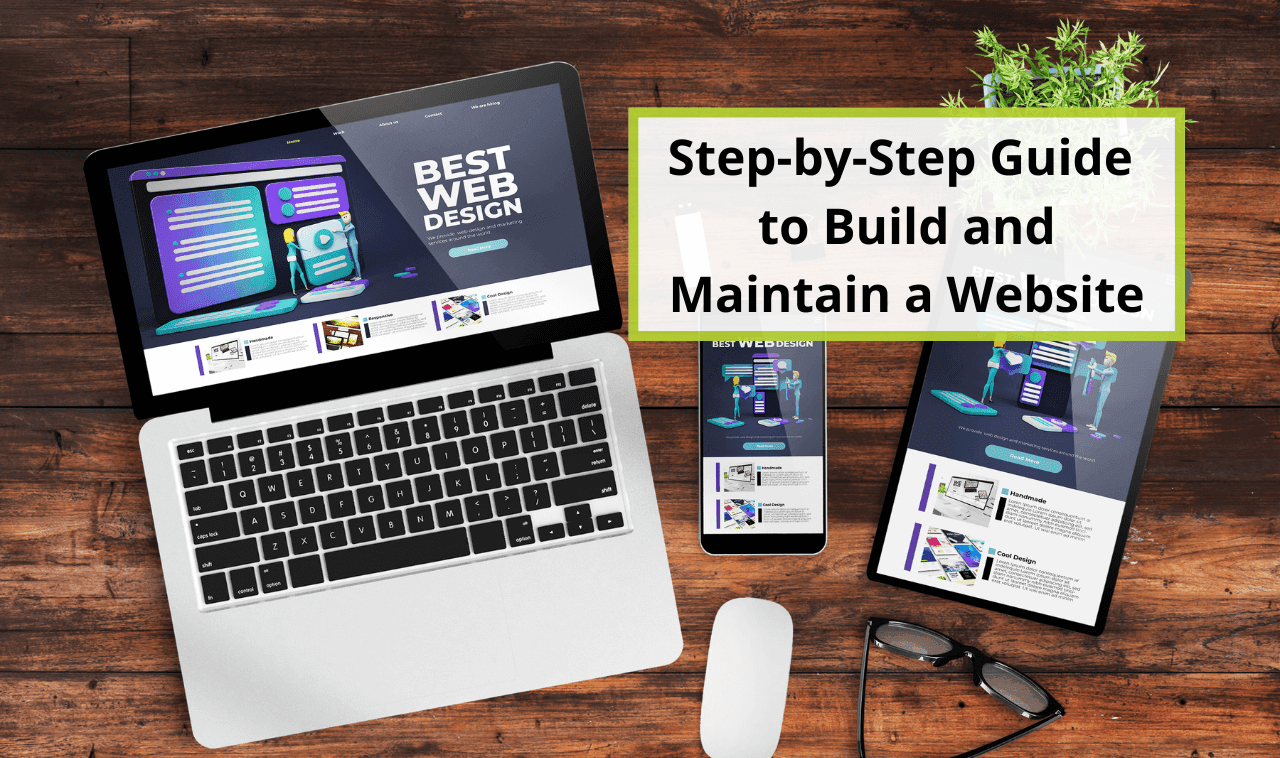Building a small business website can seem daunting, especially if you’re unsure where to start or how to navigate the process. Even though it seems like everyone and their mom has a website these days, it’s totally normal to be overwhelmed by the process.
In this guide, we’ll walk you through the essential steps of creating a website for your wellness business, from evaluating your needs and choosing the right platform to designing a cohesive brand experience and maintaining your site for optimal performance.
By the end of this article, you’ll have the knowledge and tools necessary to build a website that showcases your unique offerings and drives growth and success for your business.
Table of Contents:
- Small Business Websites: Where to Begin?
- Creating a Website for Your Business in 5 Steps
- Tips for Cohesive and Consistent Web Design
- How to Maintain Your Website
Small Business Websites: Where to Begin?
Creating a website for your small business is an exciting step towards establishing your online presence, reaching a wider audience, and making your business feel a bit more “real.” But don’t let this excitement stand in front of strategy.
While you can feel the pressure to quickly get “established” online, before you dive into the process of building your website, it’s essential to clarify your specific business needs and goals (your “why”) and your resources and your technical capabilities (your “how”).
By taking time to understand things like your level of tech literacy, available budget, and the various tools or subscriptions you need, you can make a confident decision when choosing a website-building platform.
It should align with your business needs and goals and ensure that it is as seamless for you to operate as it is for your clients to navigate.
Your Website Why and How: Evaluate Your Needs, Goals, and Resources
Before embarking on your website creation journey, it is crucial to assess your business needs, goals, and available resources. Each of these factors will heavily influence your approach to not only how your website looks but also the platforms you choose, how your website works at every touchpoint, and how much effort it will take to maintain it.
Depending on the size and nature of your wellness business, you may require different functionalities, like hosting digital content like blog articles and videos, offering online booking, processing payments, measuring web analytics, client management, and more. To help you evaluate your needs and make informed decisions, consider the following questions:
- What is the primary purpose of your website? Is it to provide information, generate leads, sell products or services, or a combination?
- Who is your target audience? What features and functionalities will they expect from your website to have a seamless user experience?
- What is your niche? How can your website communicate your unique value to your target audience?
- What is your budget for website development, hosting, and ongoing maintenance? Consider upfront and recurring costs (money, labor, and time).
- What level of technical expertise do you or your team possess? How comfortable are you with learning new website management skills?
Find a Website Builder to Support Your Business and Grow
Now that you have a basic understanding of your why and how, it’s time to start exploring your website builder options—and there are plenty to choose from. This work you’ve done on the front end will give you a tremendous advantage when evaluating providers, arming you with knowledge and questions to make the search more efficient.
You can opt for all-purpose solutions like Wix or Squarespace, which offer a wide range of templates and features for different industries. The generic approach can be tempting to those who haven’t done the legwork you already have. You’re not looking for a website builder designed for everyone. You’re looking for the right one for you. That made-for-everyone model often lacks industry-specific features, your niche needs, and ease of use — usually leading to extra costs, subscriptions, and support.
We recommend considering an all-in-one business management option explicitly designed for the wellness industry, such as OfferingTree, which already provides features and integrations that align with the unique requirements of your niche.
Luckily, most platforms offer free trials or demos where you can ask questions and try out functionality yourself with minimal cost, time, or risk to you or your business. During that process, have your how and why notes handy, and consider the following tips:
- Look for platforms that offer wellness industry-specific features like online booking and class scheduling, on-demand content, client management, analytics, and more.
- Ensure the website builder provides seamless integrations with your current or desired tools and software to streamline your operations.
- Ask about the platform’s scalability and how it can support your business as it grows and evolves.
- Test the platform’s user-friendliness, customization options, and overall functionality.
- Ask about customer support and resources provided to help you make the most of the platform.
Creating a Website for Your Business in 5 Steps
Creating a wellness business website doesn’t have to be overwhelming. By following these five simple steps, you can turn this seemingly complex project into a manageable, even fun, journey toward business mastery.
Each step is designed to help you build a strong foundation for your online presence, ensuring that your website looks beautiful, effectively serves your business goals, and connects with your ideal clients.
Step 1: Strategic Planning
Establishing a solid strategic foundation is crucial for your wellness practice, business, and website. That means knowing what your website is for (purpose), who it is for (audience), and what it is intended to do (function).
Part of this work involves defining your brand, understanding your target audience, and setting clear goals for your online presence. By having a well-defined strategy in place, you can ensure that your website authentically represents your business, connects with your current and ideal clients, and supports your overall business goals and objectives before you even build it.
A clear strategic plan will guide your decision-making throughout the website development process, from choosing the right platform to determining the content and functionality of each page of your website. Consider the following key page types and how your brand strategy will influence their content and design:
- Home: The entry point to your website that introduces your brand, business, and unique value proposition and invites visitors to explore further.
- About: This is the place for your personal or brand story, the place to share your expertise and build trust with your target audience.
- Schedule: The clear, organized location for clients to book classes, appointments, or workshops.
- Services/Packages: A showcase of your offerings and their benefits.
- Products/Online Store: A storefront to sell your offerings, content, or products that encourage purchases.
- Contact: A clear, accessible point of engagement and connection for potential clients to contact you.
- Blog: Your place to share original, valuable insight, education, and expertise to add value to your client experience and establish your authority in your niche.
Step 2: Build Around Your Services
As a wellness professional, your services are the heart of your business. This is doubly true for your online presence — and your website should be built with that in mind. When creating your website, it’s essential to structure it to highlight your offerings and make it easy for clients to find, understand, and engage with them.
To achieve this, you’ll need a website builder that provides features specifically designed for service-based businesses. For example, a platform that offers integrated booking and payment systems allows your clients to schedule appointments or classes easily, safely, and securely.
Other features to consider include:
- Digital content delivery
- Live hosting options
- Ability to create packages and memberships that work with your business model
Customizable page templates built into the software can be incredibly helpful — especially if you don’t want to design everything from scratch. They give you a head start in the design process, saving you time and effort while allowing you to communicate your unique brand.
Here are some key highlights to consider when building your website around your services:
- Seamless integration: Choose a website builder that seamlessly integrates booking, payment, and content delivery features to provide a smooth user experience for your clients.
- Customizable offerings: Ensure that the platform allows you to create and showcase your unique packages, memberships, and services in a way that reflects your brand.
- Flexible content delivery: Look for a website builder that supports various content formats, such as videos, live streams, newsletters, social media, and downloadable resources, to cater to different learning preferences.
Step 3: Content Considerations
When delivering wellness services to your clients, keeping best practices and user experience in mind is crucial. The same is true for how you approach your website content.
Clients process information in different ways, and how you structure your visual and written content plays a significant role in how effectively your website connects with them.
Well-organized, visually appealing content enhances the user experience (UX) and strengthens your brand’s credibility and professionalism. However, the opposite is also true: if your web content is a mess, your visitors will think your business is a mess and search for a competitor who makes a stronger positive impression.
But by using a combination of some simple industry best practices and a platform that can support them, you can ensure you develop your website content that avoids common pitfalls, represents your brand authentically, and connects with your audience:
- Clear and concise messaging: Is your content easy to understand, free of jargon, and effectively communicating your unique value proposition?
- Visually engaging layout: Are you using a clean, visually appealing design that incorporates whitespace, images, and videos to break up text and keep readers engaged?
- Mobile-friendly design: How will your content look on mobile devices? Is it easily accessible and readable across various screen sizes?
Step 4: Optimize for Search
If building a website is like building a brick-and-mortar store, then Search Engine Optimization (SEO) is like giving people looking for you online its exact address. Technically speaking, it’s the process of strategically, naturally seeding your website with relevant keywords and phrases to rank higher in search engine results pages (SERPs), helping your audience find your website as quickly and simply as possible.
SEO is essential for all websites, but small business websites in particular.
SEO helps increase your online visibility, drive organic traffic, and attract potential clients actively searching for your services. By appearing higher in search results, you can save your audience the hassle of endless searching, cut through the competition, and establish your brand as a trusted authority in your niche.
While SEO involves various complex strategies, you don’t need to be a tech wiz to make some significant strides on your own. Here are a few basic techniques that can help new websites improve your visibility:
- Keyword research: Identify the words and phrases your target audience uses to search for your services; strategically and naturally incorporate them into your website content.
- On-page optimization: Ensure that your website’s structure, headings, meta tags, and content use your target keywords and provide a clear hierarchy (order) of information.
- Internal Linking: Link to other relevant pages on your site to keep users engaged and spending more time exploring your website. Fix any broken links.
- Accessibility Compliance: Ensure your website is accessible to users with disabilities.
Download Our Guide to Local SEO for Small Business to Lay the Foundation for Your Website
Step 5: Launch Your Website
Now, the part that’s equally thrilling and nerve-wracking — it’s time to launch your website. Before you go live, DO NOT FORGET to register your domain name (basically the web equivalent of an address on a house).
Your domain name is your online identity and helps clients find your business easily. For example, our domain name is OfferingTree.com. A good website hosting platform should make registering your domain a breeze. If not, seek a different platform.
Before launching your website, you’ll want to thoroughly test your website’s functionality, security, and user experience across different devices and browsers.
Here are three essential pre-launch tasks to help you prepare (and remember, a good platform will make the more technical stuff easy to check off the list):
- Cross-device compatibility: Test your website on various devices, including desktops, laptops, tablets, and smartphones, to ensure it displays correctly on all screen sizes.
- Double-check links and navigation: Click through all links and menu items to ensure they work correctly and lead to the correct pages within your website and external resources.
- Security and client account flow: Verify that your website’s security measures (like SSL certificates and client account login processes) are functioning properly to protect sensitive information.
Tips for Cohesive and Consistent Web Design
When crafting a website for your wellness business, it’s crucial to ensure it functions appropriately and presents cohesive branding and consistent visual design. A unified brand identity across all channels can effectively help you consistently show up in front of your clients, wherever they find you, in a way that resonates with their needs and values AND enhances your professional image.
Even minor design choices can significantly impact user experience and conversion rates. A well-designed website with intuitive navigation, clear calls-to-action, and visually appealing elements can guide visitors toward booking a class, engaging with content like blogs or videos, purchasing a class or product package, or just returning regularly. On the other hand, inconsistent or cluttered design can lead to confusion, frustration, and, ultimately, fewer clients.
Consider the following design best practices for web design cohesion and consistency:
- Maintain a consistent color palette and typography: Use colors and fonts that align with your brand identity and evoke the desired emotions in your visitors.
- Prioritize simplicity and clarity: Avoid clutter and focus on delivering your key messages and calls-to-action in a clear, concise manner.
- Optimize for mobile devices: With the increasing use of smartphones and tablets, ensure that your website is responsive (automatically adjusts to the screen) and easily navigable on various screen sizes.
How to Maintain Your Website
Just like your body, home, and physical studio space, your website requires regular maintenance to ensure it stays in top shape and continues to provide an excellent experience for your clients. More specifically, website maintenance involves a set of ongoing tasks and best practices to keep your site secure, up-to-date, and functioning optimally.
By dedicating a little time and effort to website maintenance, you can prevent potential issues, enhance performance, and ensure that your online presence grows your wellness business.
Updates and Security Checks
Creating a safe environment for your clients is essential to delivering effective service. The same is true for your website. This is particularly true for wellness businesses that handle sensitive client information and process online payments. Keeping your website software, plugins, themes, and security measures up-to-date protects your business and clients from potential vulnerabilities, data breaches, and cyber threats.
Regularly performing updates and security checks ensures that your website runs smoothly, efficiently, and securely. This not only provides a better user experience for your clients but also helps maintain their trust and confidence in your brand.
Neglecting these crucial tasks can lead to website downtime, compromised client data, and significant financial and reputational damage to your business. With the right platform, these updates should either be automatic or require very little effort on your part.
Whether setting up your website or selecting a platform, consider how easy it will be to:
- Regularly update your website platform, themes, and plugins: Stay informed about new releases and security patches, and promptly apply them to minimize vulnerabilities.
- Implement robust security measures: Use SSL certificates, secure payment gateways, and strong password policies to protect your website and client data from unauthorized access.
- Perform frequent backups: Regularly back up your website files and database to ensure that you can quickly restore your site in case of any security breaches or technical issues.
- Respond to breaches: In the event of a data breach or related security issue, have a protocol outlined for managing it and protecting or reassuring your clients.
If any of this feels complicated or daunting, don’t worry. The right platform provider should be able to answer any questions you have about these areas and have support in place to ensure this crucial aspect of your online business is taken care of. If not, you might want to consider a different platform.
Ongoing SEO Tasks
Like any organic practice, SEO is not a one-time task but an ongoing process requiring regular attention and effort. But when you have the right platform, strategy, and foundation, this process is more fun than frustrating.
But why can’t you just set it and forget it? Well, as search engine algorithms evolve and user behavior changes, SEO strategies must adapt accordingly. Keeping up with SEO best practices ensures that your website will remain visible, relevant, and engaging to your target audience — and competitive in the wellness space.
It’s worth the effort. Before you know it you’ll be reaping the rewards. Maintaining a strong SEO presence shows that you are actively improving and maintaining your website. Plus, it generates consistently increasing organic traffic, higher conversion rates, and improved brand presence and credibility.
Putting in the work to consistently provide valuable, optimized content and ensure an easy user experience, you can establish that your business is not only an expert in your niche but one that puts your clients first. This, in turn, can lead to increased client loyalty, word-of-mouth referrals, and long-term growth.
To effectively manage and maintain your SEO efforts, be sure to practice the following regularly:
- Monitor your keyword rankings: Regularly track your website’s rankings for target keywords; adjust your strategy as needed to maintain or improve your search position.
- Analyze your website’s performance: Use analytics tools (more on that in the next section) to monitor your website’s traffic, bounce rates, and conversion rates, and identify areas for improvement.
- Update and refresh your content: Regularly add new, relevant content to your website and update existing content to keep it fresh and engaging for users and search engines alike.
Decoding Web Analytics
There’s no getting around it: website analytics data (see, we told you we’d get into it) plays a crucial role in maintaining and managing your wellness business website. Website analytics data covers many metrics, including traffic sources, page views, bounce rates, conversion rates, and user demographics.
And, although this topic can make the right-brained among us feel a bit daunted, you’ll quickly see how important (and simple) they can be for the success of your website and business, especially with the right website analytics tools.
Web analytics data provides insights into how visitors interact with your site, revealing patterns, trends, and areas for improvement by the numbers. By regularly monitoring and analyzing this data, you don’t have to guess how users interact with your site, what their pain points are, or what changes you should make to improve their experiences.
With web analytics in hand, you can make informed decisions to optimize your website’s performance, enhance user experience and satisfaction, and ultimately drive growth.
Understanding and interpreting this data allows you to:
- Identify your most popular content and services, enabling you to focus on what resonates best with your target audience.
- Pinpoint problem areas of your website that may be causing visitor frustration or confusion, allowing you to make targeted improvements to reduce bounce rates and increase engagement.
- Track the effectiveness of your marketing efforts, such as social media campaigns or email newsletters, by monitoring the traffic and conversions they generate.
Download Our Step-by-Step Guide to Brand Development for Your Business
Create Your Small Business Website, Manage Operations, and Grow with OfferingTree
At OfferingTree, we understand the unique needs of wellness entrepreneurs and provide an all-in-one platform designed specifically for your industry. With features like online booking, content delivery, client management, and built-in analytics, OfferingTree simplifies the process of creating and maintaining a professional website that drives results.
Start your journey today with a 14-day free trial to discover how OfferingTree can help you streamline your operations, connect with your clients, and grow your wellness business. Build more than a website; build a thriving online presence with OfferingTree.








